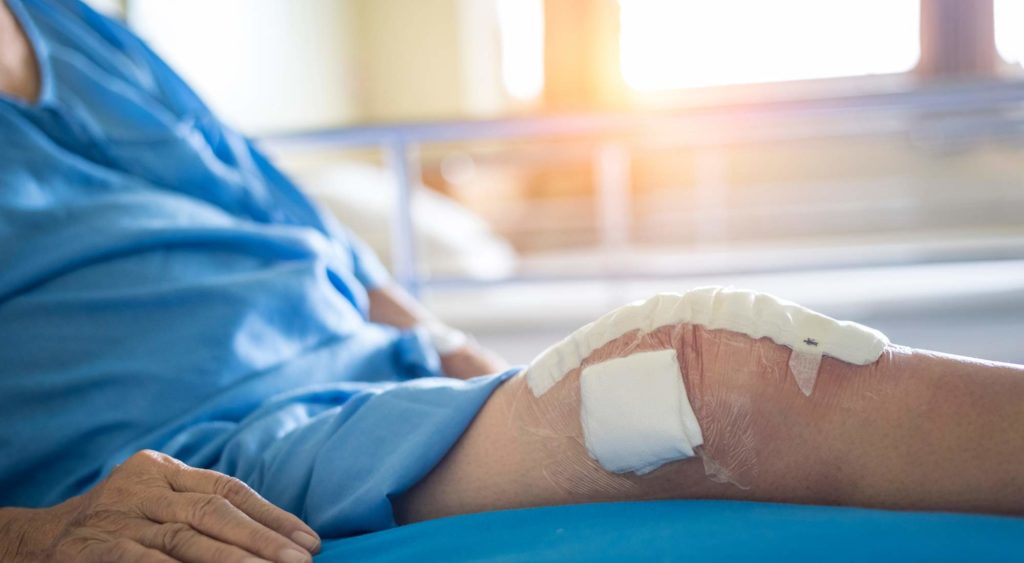Knee Replacement Physical Therapy

Physical Therapy for Knee Replacement – Information, Exercises, and More
You’re facing a knee replacement. Or maybe you’ve already had the surgery.
You are no stranger to pain and you want to know your options for relief and recovery.
If you want to regain mobility and use of your knee, you need to know your options.
This guide will tell you about knee replacement surgery and some choices you have for treatment and recovery.
What is a Knee Replacement Surgery?
Also called knee arthroplasty, knee replacement surgery replaces the weight-bearing parts of your knee with artificial parts.
Knee replacement surgery is usually done as a way to relieve severe pain in your joint and replace damaged parts of your joint.
What Causes The Need for a Knee Replacement?
Joints can wear out with time and overuse. Arthritis can cause extreme pain. Clotting or poor circulation can damage your bones. Genetic deformities can cause uneven wear on your knee joint.
Whatever the reason for needing knee replacement surgery, the procedure is common and generally has a good outlook for recovery.
Below, we’ll review a few common situations that can lead to knee replacement surgery in detail.

Arthritis
Arthritis is the most common reason for knee replacement surgery.
Patients with advanced arthritis often find relief from pain and enjoy a better quality of life after knee replacement surgery.
These patients are usually older and have advanced arthritis symptoms.
Injury
Suffering from a major knee injury can change your life.
Fractures to the femur or patella can also lead to knee replacement surgery.
If you have damaged the cartilage or torn a ligament, these injuries could cause damage to the knee that is so severe, the knee must be repaired with prosthetic pieces.
You could also develop arthritis after an injury. Post-traumatic arthritis is the third most common reason for knee replacement.
Blood Disorders
Bone death due to a blood disorder can require total knee replacement. It could be caused by a blood clot, or by hemophilia.
Hemophilia is a blood disorder that prevents the blood from clotting properly and could potentially cause severe arthropathy and pain.
Deformity
Genetic abnormalities, such as severe varus and valgus deformities, can be improved by replacing part of the knee.
The surgery can help patients who have suffered from damage to the components of the knee due to misalignment.
Knee Replacement: Symptoms After Surgery
Patients report a variety of symptoms immediately after knee replacement surgery.
While every patient is different and will experience knee replacement in a unique way, there are common symptoms that doctors address prior to, and following, surgery.
Pain
Pain can become a serious concern if it is not managed, beginning immediately after surgery.
Many patients report moderate to severe following surgery, but the pain lessens in a short period of time.
Stiffness
Stiffness following knee surgery is often a result of swelling or lack of movement.
Your doctor will give you instructions for after your surgery that can help prevent or relieve stiffness.
This feeling often subsides once rehabilitation begins.
Swelling
Swelling is not uncommon following knee replacement surgery.
Some doctors will advise you to elevate your knee and use ice to help relieve these symptoms.
If the swelling does not go down, you should follow up with your doctor regarding potential complications.
Knee Replacement: Treatment Options
Your doctor will have a treatment plan to recommend for you after knee replacement surgery. Physical therapy exercises will likely be an important part of your rehabilitation.
Different treatments play important parts in helping you get back on your feet.
Pain Management
Following knee replacement surgery, your doctor will probably talk to you about pain management options.
Pain is a serious consideration following surgery. Higher levels of pain can be linked to complications and should be discussed with your doctor.
There are several options your doctor may consider or present to help manage your pain levels and keep you more comfortable after knee replacement surgery.
These options can include:
- NSAIDs (such as ibuprofen)
- Over-the-counter pain relievers (such as acetaminophen)
- Opioid pain relievers (such as tramadol or oxycodone)
- Extended-release local anesthetic
- Physical therapy
Deciding on how to best manage your pain is based on your individual circumstances and how much pain you are in post-surgery.
RICE Treatment
RICE stands for rest, ice, compression, and elevation. Your surgeon or physical therapist may suggest this treatment if you are experiencing swelling.
Swelling can be a concern after knee replacement surgery because it can make your rehabilitation more difficult.
Physical Therapy
Part of your treatment and rehabilitation plan will likely be physical therapy. It is a common part of the treatment protocol for knee replacement surgery.
Many patients report better results with physical therapy following surgery.
This can mean:
- Less pain
- More mobility
- Improved physical function
Knee Replacement Physical Therapy – Will PT Help?
Most doctors recommend physical therapy after knee replacement surgery because of the outstanding results it can offer.
Physical therapy can help you:
- Regain motion
- Improve symptoms, such as stiffness and lack of mobility
- Help you build strength to protect your new knee
Talk to your doctor about the best treatment plan for you.
Best Knee Replacement Physical Therapy Exercises
Every patient is different. There is not a single prescribed set of exercises for all knee replacement patients because each person has unique concerns and needs.
There are some basic exercises that have been found to be helpful for most patients to regain mobility and strength.
Before starting any exercises after knee replacement surgery, you should see a Doctor of Physical Therapy, like the ones at In Motion O.C., to find out what exercises are best for you.
Sitting Knee Extension
Sitting knee extensions can help you regain the ability to straighten your leg.
You can try several repetitions of the exercise to increase the ability to extend until you can hold your knee out straight in front of you.
Sitting Knee Flexion
Sitting knee flexions can help you regain the ability to bend your knee for things like sitting comfortably, driving, or squatting.
You can try several repetitions of the exercise to increase the ability to extend until you can bend your knee to a ninety-degree angle.
Ankle Pumps
You can do ankle pumps from just about anywhere.
Ankle pumps are often recommended for improving circulation and relieve swelling.
These can be repeated for several repetitions, and many times a day. You can even perform ankle pumps while you are elevating and icing your knee.
Heel Slides
Heel slides are usually intended to help you stretch and strengthen the muscles of the thigh.
You may want to repeat this motion for several repetitions to stretch and strengthen the muscles in your thigh.
Placing a towel under your heel can help you slide your heel easier and reduce friction.
Leg Slides
Leg slides are commonly done to strengthen your core muscles and leg muscles.
You may want to repeat this exercise any time you are laying down to build those muscles and aid in rehabilitation.
How In Motion O.C. Can Help With Your Knee Replacement Recovery
If you have had knee replacement surgery, you deserve personalized care that will get you back on your feet.
You can trust the experts at In Motion O.C. because they have successfully helped thousands of patients reduce pain and regain mobility so they can get back to their lives.
You don’t have to take our word for it: Yelp users have rated us number one in the nation for physical therapy.
In Motion O.C. cares about your recovery and will work with you to find treatment options that fit your unique needs.
*This information about physical therapy for knee replacement was reviewed by Dr Natalie Thomas, PT, DPT. If you have any questions, please don’t hesitate to contact us here.


